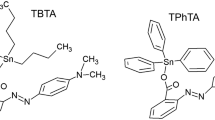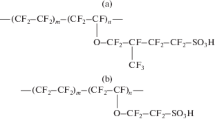Summary
The disulfonic acid stilbene derivative SITS reported to be covalently bonded to the membrane of the red blood cell, was found to be largely reversibly bound. Reversal of its specific inhibitory effect on anion permeability was attained by washing the cells with buffer containing albumin. The small fraction of covalently bonded SITS could be increased by prolonging the time of exposure of the cells or by multiple exposures. A series of other disulfonic stilbene derivatives was synthesized. All of them specifically inhibited anion permeability whether or not they are capable of forming covalent bonds. Their inhibitory effectiveness, however, varied over a 5,000-fold range, allowing certain conclusions to be made concerning the chemical architecture of the binding site. Certain of the compounds were almost entirely covalently bonded. One of them was labeled with125I and used to determine to which membrane proteins the compound is bound. Over 90% was found in a protein band on acrylamide gels of 95,000 mol wt. The most effective compound against sulfate permeability was equally effective against chloride permeability, producing a maximum inhibition of over 95%. The residual anion fluxes respond differently to pH and temperature than do the fluxes of unmodified cells.
Similar content being viewed by others
References
Berg, H. C. 1969. Sulfanilic acid diazonium salt: A label for the outside of the human erythrocyte membrane.Biochim. Biophys. Acta 183:65.
Bretscher, M. S. 1971. Human erythrocyte membranes: Specific labelling of surface proteins.J. Mol. Biol. 58:775.
Dacie, J. V., Lewis, S. M. 1968. Practical Hematology. Grune and Stratton Inc., New York. p. 481.
Deuticke, B. 1970. Anion permeability of the red blood cell.Naturwissenschaften 4:172.
Dodge, J. T., Mitchell, C., Hanahan, D. 1963. The preparation and chemical characteristics of hemoglobin free ghosts of human erythrocytes.Arch. Biochem. Biophys. 110:119.
Fairbanks, G., Steck, T. L., Wallach, D. F. H. 1971. Electrophoretic analysis of the major polypeptides of the human erythrocyte Membrane.Biochemistry 10:2806.
Fortes, P. A. G., Hoffman, J. F. 1971. Interactions of the fluorescent anion 1-Anilino-8-Naphthalene sulfonate with membrane charges in human red cell ghosts.J. Membrane Biol. 5:154.
Good, N. E., Winglet, G. D., Winter, W. Connally, T. N., Izawa, S., Singh, R. M. M. 1966. Hydrogen ion buffers for biological research.Biochemistry 5:467.
Gunn, R. B., Tosteson, D. C. 1971. The effect of 2,4,6-Tinitro-m-Cresol on cation and anion transport in sheep red blood cells.J. Gen. Physiol. 57:593.
Helmkamp, R. W., Sears, D. A. 1970. A label for the red cell membrane: Diazotized diiodosulfanilic acid.Int. J. Appl. Rad. Isotopes 21:683.
Hoffman, J. F., Lassen, U. V. 1971. Plasma membrane potentials in amphyuma red cells, 25.Int. Congr. Physiol. Sci., (Munich) Abstr. No. 746.
Itzhaki, R. F., Gill, D. M. 1964. A microbiuret method for estimating proteins.Analyt. Biochem. 9:401.
Knauf, P. A., Rothstein, A. 1971. Chemical modifications of membranes. I. Effects of sulfhydryl and amino reactive reagents on anion and cation permeability of the human red blood cell.J. Gen. Physiol. 58:190.
Kotaki, A., Naoi, M., Yagi, K. 1971. A diamino stilbene dye as a hydrophobic probe for proteins.Biochim. Biophys. Acta 299:547.
Lepke, S., Passow, H. 1971. The permeability of the human red blood cell to sulfate ions.J. Membrane Biol. 6:158.
Maddy, H. 1964. A fluorescent label for the outer components of the plasma membrane.Biochim. Biophys. Acta 88:390.
Passow, H. 1969. Passive ion permeability of the erythrocyte membrane.Progr. Biophys. Mol. Biol. 19:424.
Passow, H., Schnell, K. F. 1969. Chemical modifiers of passive ion permeability of the erythrocyte membrane.Experientia 25:460.
Phillips, D. R., Morrison, M. 1971. Exposed protein on the intact human erythrocyte.Biochemistry 10:1766.
Poensgen, J., Passow, H. 1971. Action of 1-Fluoro-2,4-Dinitrobenzene on passive ion permeability of the human red blood cell.J. Membrane Biol. 6:210.
Ponder, E. 1948. Hemolysis and Related Phenomena. Grune and Stratton Inc., New York.
Resch, K., Imm, W., Ferber, E., Wallach, D. F. H., Fischer, H. 1971. Quantitative determination of soluble and membrane protein through their native fluorescence.Naturwissenschaften 58:220.
Saunders, K. H. 1949. The Aromatic Diazo-Compounds and their Technical Application. Edward Arnold, London. 2nd Edition.
Singer, S. J. 1967. Covalent labelling of active sites.Advanc. Protein Chem. 22:1.
Wieth, J. O. 1971. The selective ionic permeability of the red cell membrane.In: Oxygen Affinity of Hemoglobin and Red Cell Acid-Base Status. M. Rorth and P. Astrup, editors. p. 265. Munksgaard, Copenhagen.
Author information
Authors and Affiliations
Additional information
This paper is based on work performed in part under contract with the U.S. Atomic Energy Commission at the University of Rochester Atomic Energy Project (Report No. UR 3490-199) and in part by the Medical Research Council of Canada, Grant No. MA-4665. Z. I. Cabantchik was the recipient of an International Atomic Energy Agency (Vienna) Fellowship.
Rights and permissions
About this article
Cite this article
Cabantchik, Z.I., Rothstein, A. The nature of the membrane sites controlling anion permeability of human red blood cells as determined by studies with disulfonic stilbene derivatives. J. Membrain Biol. 10, 311–330 (1972). https://doi.org/10.1007/BF01867863
Received:
Issue Date:
DOI: https://doi.org/10.1007/BF01867863




